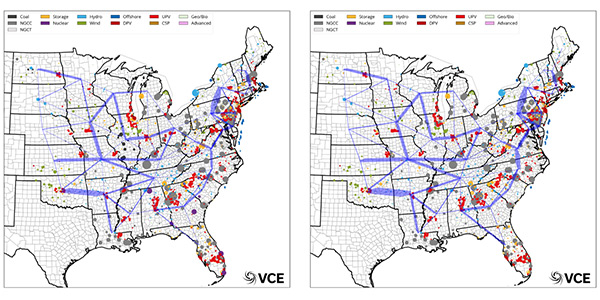A “macro grid” that allowed transmission of cheap renewable energy throughout the Eastern Interconnection would produce $7.8 trillion in private investment, create 6 million jobs, cut carbon emissions and save consumers more than $100 billion, according to a study released Wednesday by clean energy advocates.
“Most of America’s world-class renewable resources are currently stranded in remote areas where the power grid is weak to nonexistent,” said the report by Americans for a Clean Energy Grid (ACEG), a coalition that includes the American Wind Energy Association, WIRES, transmission operator ITC Holdings and renewable generator Enel North America. “Policy barriers in how we plan, pay for and permit transmission are blocking private investment in modernizing our power grid.”
The report says its proposed transmission investments could “cost-effectively” cut electric sector CO2 emissions by more than 95% by 2050, with the region getting more than 80% of its electricity from wind and solar.
It also claims average electric rates would drop by more than one-third, from more than 9 cents/kWh today to about 6 cents/kWh.
“Just as the Eisenhower interstate highway system unleashed U.S. manufacturing in the 20th century, a strong macro grid will deliver massive economic and public health benefits for all Americans in the 21st century,” ACEG Executive Director Rob Gramlich said.
The report does not identify the “policy barriers” nor recommend ways to overcome them. The authors said their focus was to illustrate the complementary roles that wind, solar, storage and transmission play in providing reliable and affordable power.
4 Scenarios
The report includes four scenarios, including a “strong carbon reduction” case in which transmission costs would average 3.6% of total electricity costs. “Transmission yielded savings many times greater than that by providing access to low-cost renewable resources and increasing the overall efficiency of the power system,” it said.
It projects a fivefold increase in electric sector employment, with more than 6 million net new jobs.
“This job creation is driven by as much as $7.8 trillion in generation and transmission investment across the eastern U.S. through the year 2050,” it said. “Several states receive more than $400 billion in additional investment in generation and transmission, driving up tax revenue, indirect job creation outside of the electric sector and broader economic development. The vast majority of this investment will flow to economically depressed rural areas.”
The report includes two “weak carbon policy” scenarios — one with high solar deployment and one with high wind deployment — created by extrapolating the “business as usual” rate of CO2 emissions reductions from 2005 to 2017.
“Strong carbon policy” cases were based on meeting the Paris Agreement requirements.
The weak-carbon, high-solar scenario was estimated to require the addition of less than 80,000 GW-miles of interstate transmission by 2050 while the two strong carbon cases would add about 140,000 GW-miles. (A 500-mile transmission line that carried 2 GW would equal 1,000 GW-miles.)
“Many of the same transmission upgrades were built across all four scenarios, indicating these investments will be needed regardless of future trends in renewable costs or carbon reductions. The model also used battery storage to increase the utilization of transmission lines, demonstrating that storage is a transmission complement, not a substitute,” it said. “Storage, particularly storage that is strategically sited near wind and solar resource areas, can complement transmission investment by increasing the utilization factor of transmission lines.”
The high-solar scenario deploys much of the storage in the East, particularly the Southeast, to shift excess daytime production to the night.
The high-wind scenario would put much of the storage in western states such as Kansas and South Dakota. “Notably, much of that storage shifted out of Indiana and Pennsylvania, where expanded west-east transmission delivering wind generation to the Northeast steps in to replace the need for storage,” the report says.





